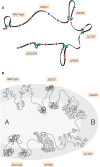Cohesin: building loops, but not compartments
- PMID: 29217589
- PMCID: PMC5730885
- DOI: 10.15252/embj.201798654
Cohesin: building loops, but not compartments
Abstract
DNA is subjected to major cellular events, such as transcription, replication and
Figures

Comment on
-
A mechanism of cohesin-dependent loop extrusion organizes zygotic genome architecture.EMBO J. 2017 Dec 15;36(24):3600-3618. doi: 10.15252/embj.201798083. Epub 2017 Dec 7. EMBO J. 2017. PMID: 29217590 Free PMC article.
-
Topologically associating domains and chromatin loops depend on cohesin and are regulated by CTCF, WAPL, and PDS5 proteins.EMBO J. 2017 Dec 15;36(24):3573-3599. doi: 10.15252/embj.201798004. Epub 2017 Dec 7. EMBO J. 2017. PMID: 29217591 Free PMC article.
References
-
- Nasmyth K (2001) Disseminating the genome: joining, resolving, and separating sister chromatids during mitosis and meiosis. Annu Rev Genet 35: 673–745 - PubMed
Publication types
MeSH terms
Substances
LinkOut - more resources
Full Text Sources
Other Literature Sources

